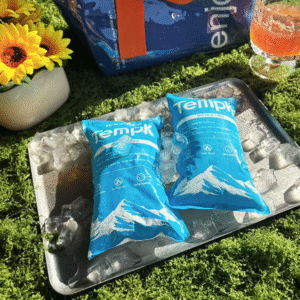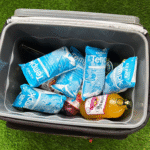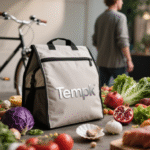Reviews Dry Ice Pack Sheet: Which One Wins 2025?
If you search reviews dry ice pack sheet, you want clear answers fast. This guide compares formats, shares test methods, and shows how to size for 24–72 hours. You’ll get simple math, Verpackungs-SOPs, and buyer checklists you can apply today to food, Pharma, and lab routes.
-
Welche dry ice pack sheet reviews criteria matter most for real lanes?
-
How many sheets deliver 24, 48, Und 72 hours across seasons?
-
What format of insulated dry ice pack sheet fits your product and budget?
-
Wie packst du ein, Etikett, and ship a Trockeneisschütze safely and repeatably?
How did we run reviews dry ice pack sheet Tests?
Kurze Antwort: We scored each insulated dry ice pack sheet on hold time per kilogram, edge-temperature stability, CO₂ venting, Haltbarkeit, and pack-out repeatability. Scores came from repeatable parcel and pallet simulations with controlled ambient profiles and identical payloads.
Warum ist das wichtig: Fancy specs don’t help if the sheet fails in real routes. We used simple, repeatable steps you can copy. Ambient cycles covered cool nights and hot afternoons. We logged center and corner temperatures, Netto -Trockeneismasse, and visible damage. This makes dry ice pack sheet reviews praktisch, not theoretical.
Dry ice pack sheet review criteria: what matters most?
-
Hold time per kilogram: How many hours per kg under target temp?
-
Edge stability: Corners are where spoilage starts.
-
Venting behavior: CO₂ must escape without ballooning the liner.
-
Tear/abrasion resistance: Does the sheet survive tight corners?
-
Pack-out repeatability: Can new staff get the same result?
| Review Criterion | What we look at | How it’s measured | Für dich |
|---|---|---|---|
| Hold time/kg | Hours per kilogram of dry ice | Datenlogger + mass tracking | Right-size your fill |
| Edge stability | Corner vs center delta | ΔT over time at corners | Weniger Hot Spots |
| Entlüftung | Gas escape vs swelling | Visual + pressure feel | Safer shipments |
| Haltbarkeit | Tears, fray, seam issues | Post-run inspection | More re-use cycles |
| Repeatability | SOP variance | Std. dev. across packers | Fewer surprises |
Practical tips to copy our reviews dry ice pack sheet setup
-
Control the ambient. Use a repeatable 20–30 °C cycle.
-
Use identical payloads and box insulation.
-
Standardize data loggers and probe placement.
-
Photograph every pack-out to document sheet position.
Schnappschuss des Falles: A bakery switched to a wall-lined insulated dry ice pack sheet plus a thin pellet top layer. Summer returns dropped, and average dry ice fill fell by about one sixth on Friday routes.
Welche reviews dry ice pack sheet formats fit your use case?
Kurze Antwort: Vacuum-sealed sheets are clean and stable for pharma; quilted/stitched sheets bend well for e-commerce; reflective-faced sheets fight radiant heat in summer. Pick based on payload risk, cleanliness, and lane temperature.
Longer view: There is no single “best” Trockeneisschütze. Your winner depends on ambient peaks, desired duration, und Handling. Use the matrix below to match format to job.
Vacuum-sealed vs quilted vs reflective: what changes?
-
Vacuum-sealed: Wipeable, low lint, consistent thickness.
-
Quilted/stitched: Conforms around corners; check thread at −50 °C.
-
Reflective-faced: Reduces radiant gain from warm walls and lids.
| Format | Hold Time Potential | Flexibilität | Sauberkeit | Typische Verwendung |
|---|---|---|---|---|
| Vacuum-sealed sheet | Hoch | Medium | Hoch | Pharma, labs, clean pack rooms |
| Quilted/stitched sheet | Medium-High | Hoch | Medium | Essen, Mahlzeiten, multi-SKU boxes |
| Reflective-faced sheet | High in summer | Medium | Medium | Heiße Spuren; last-mile afternoons |
Use-case quick picks
-
Delicate biologics (2–8 ° C): Vacuum-sealed sheet on walls + PCM barrier.
-
Gefrorene Meeresfrüchte (−18 °C): Quilted sheet for corners + pellet top-off.
-
Heiße Sommerspuren: Reflective-faced sheet + vent-friendly lid liner.
Sizing your Trockeneisschütze in minutes—what works?
Kurze Antwort: Start with a simple baseline, then adjust for ambient peaks and box quality.
Baseline rule: For parcels at 15–25 °C, planen ~1.0 kg of dry ice per 10 L per 24 Std.. A full perimeter of insulated dry ice pack sheet can trim required fill by ~10–20% by smoothing sublimation and protecting corners.
Step-by-step you can copy:
-
Calculate internal volume in liters.
-
Wählen 24/48/72 Std..
-
Dry ice mass = Volume/10 × Days × 1.0 kg.
-
If fully wall-lined with a sheet, reduce by 10–20% (halten 10% safety in summer).
-
Convert mass to the number of sheets (based on per-sheet weight) and add a thin pellet top layer if lanes exceed 28–30 °C.
Two-minute calculator (Fügen Sie in Ihre SOP ein)
| Box Volume (L) | Target Hours | Grundlinie (kg) | With Sheet (−15%) | Summer Safety (+10%) | If Sheet = 0.75 kg | You’ll Pack |
|---|---|---|---|---|---|---|
| 18 | 24 | 1.8 | 1.53 | 1.68 | 2.24 Blätter | 2–3 sheets + thin pellets |
| 22 | 48 | 4.4 | 3.74 | 4.11 | 5.48 Blätter | 5–6 Blätter |
| 30 | 72 | 9.0 | 7.65 | 8.42 | 11.23 Blätter | 11–12 sheets |
Self-test: are you under-filling?
-
Your corners rise >6 °C above center before arrival.
-
You see condensation on inner walls early in transit.
-
You add “just in case” pellets after closing the lid.
If two items are true, Fügen Sie einen hinzu Trockeneisschütze panel or increase pellet top-off by 10%.
Pack-out SOP with a Trockeneisschütze—what’s the right order?
Kurze Antwort: Create a cold perimeter with the sheet, shield the payload with a spacer or PCM, then finish with a thin pellet layer on top. Always leave a safe vent path.
Standard parcel SOP:
-
Pre-cool the box when possible.
-
Line all four walls with an insulated dry ice pack sheet.
-
Add a corrugated spacer or a +5 °C PCM barrier.
-
Center the payload away from walls.
-
Add a thin pellet pad or pellets on top.
-
Close with vent-friendly gaps; label for CO₂ as required.
Parcel vs pallet: placement differs
| Schritt | Parcel with Sheet | Pallet with Sheet | Warum ist es wichtig |
|---|---|---|---|
| Walls | 4 wall panels | Full-height hanging panels | Builds cold perimeter |
| Payload gap | Spacer/PCM | Pallet cap + center gap | Avoids cold shock |
| Top finish | Pellet pad | Pellet grid or pads | Verlängert die Haltezeit |
| Entlüftung | Lid vent gap | Dedicated vent duct | Safe CO₂ egress |
Actual lane: A specialty meat brand lined walls with a reflective Trockeneisschütze, added a perforated lid liner, and saw corner temps drop by ~3–4 °C on final-mile afternoon stops.
Safety and compliance for a Trockeneisschütze Lieferung?
Kurze Antwort: Let CO₂ vent, label correctly when required, and train staff for cold burn and handling.
What to do every time:
-
Entlüftung: Never hermetically seal a dry-ice shipper.
-
Beschriftung: Use the proper CO₂ solid label and declare net mass when rules require.
-
PS: Gloves and eye protection during pack-out.
-
Lagerung: Keep dry ice and the insulated dry ice pack sheet away from unventilated rooms.
-
Ausbildung: Make your SOP visual with photos and arrows.
Common mistakes (and fixes)
| Fehler | Why it hurts | Fast fix | Für dich |
|---|---|---|---|
| Sealing the lid airtight | CO₂ builds up and warms box | Add vent path or lid liner | Sicherheit + hold time |
| Sheet only on top | Corners warm first | Wall-line perimeter first | Fewer excursions |
| Payload touching sheet | Risk of cold shock | Spacer or PCM shield | Stable product temp |
| Overfilling pellets | Wasted mass, Druck | Right-size via calculator | Save cost |
Kosten & sustainability—do Trockeneisschütze choices pay back?
Kurze Antwort: Ja, when you focus on hold time per kilogram, sheet durability, and fewer reships. The sheet reduces overfill and corner excursions, which are your biggest cost leaks.
Where savings come from:
-
Lower fill mass: Perimeter lining smooths sublimation; you often need 10–20% less dry ice.
-
Fewer reships: Edge stability stops most failures.
-
Reusable cycles: Durable sheets reduce single-use waste.
-
Smaller boxes: Stable temps allow a size down in some lanes.
Quick ROI calculator (copy into your planning doc)
| Metrisch | Pellets Only | With Dry Ice Pack Sheet | What that means |
|---|---|---|---|
| Dry ice per 24h/10 L | ~1.1–1.3 kg | ~0.9–1.1 kg | 10–20% cut typical |
| Corner temp excursions | Höher | Untere | Fewer spoilage events |
| Box size | Medium | Sometimes smaller | Less freight cost |
2025 Trockeneisschütze trends and review highlights
Trendübersicht: In 2025, dry ice pack sheet reviews favor cleaner films, reflective outer skins for radiant control, micro-vent designs for steady CO₂ release, and easy-to-sanitize surfaces. More teams pair sheets with PCM to keep biologics in the safe zone without freezing.
Latest advances at a glance
-
Reflective facings: Fight summer heat without thicker foam.
-
Hybridpackungen (sheet + PCM): Smooth 2–8 °C and −20 °C profiles.
-
Sensor pockets: A sleeve for low-cost loggers simplifies QA.
-
Fold-line modularity: One sheet size covers multiple box sizes.
-
Low-lint surfaces: Better for clean rooms and quick wipe-downs.
Market insight: Buyers choose predictability and documentation. A clear one-page SOP and lane test snapshot can outweigh a small cost difference between insulated dry ice pack sheet formats.
Häufig gestellte Fragen
Q1: How long will an insulated sheet last in hot weather?
Verwenden Sie das 1.0 kg pro 10 L per 24 H Regel, then add 10–20% for summer lanes. A perimeter Trockeneisschütze makes that target more reliable.
Q2: Can a sheet replace pellets entirely?
Not usually. Many teams wall-line with the sheet and add a thin pellet layer on top. That combo is robust and repeatable.
Q3: Will 2–8 °C products freeze near the wall?
Add a spacer or +5 °C PCM between payload and Trockeneisschütze. That keeps temps stable without cold shock.
Q4: Which format is best for pharma?
Vacuum-sealed insulated dry ice pack sheet options are low lint and easy to sanitize. They’re a strong default.
Q5: What about last-mile lunch-time peaks?
Use a reflective-faced Trockeneisschütze and retain a vent path near the lid. This reduces afternoon radiant gain.
Q6: How do I train new packers quickly?
Photograph each step. Mark sheet positions with arrows. Das hält reviews dry ice pack sheet results consistent.
Zusammenfassung & Empfehlungen
Schlüsselpunkte: Der reviews dry ice pack sheet tests show that perimeter wall-lining stabilizes corners, reduces overfill, and improves repeatability. Vacuum-sealed sheets fit clean rooms; quilted sheets bend well; reflective sheets shine in summer. Use the simple sizing rule and confirm with lane tests.
Nächste Schritte:
-
Pick a format matched to your lanes and payload risk.
-
Run a two-lane, three-box trial with identical SOP photos.
-
Tune sheet count with the calculator and add a small pellet top layer.
-
Lock the final SOP and train with visuals.
Need a quick spec review? Share your volume, Std., and ambient peaks. We’ll return a right-sized configuration and a one-page SOP.
Über Tempk
We design reliable cold-chain solutions for food, Pharma, and research. Unser insulated dry ice pack sheet range focuses on predictable performance, durable edges, and clear documentation. Two practical advantages you’ll notice: consistent seams that don’t fray and SOPs that new packers get right on day one.
Sprich mit uns: Send your route temps, target hours, and box volume for a tailored starting spec.
























